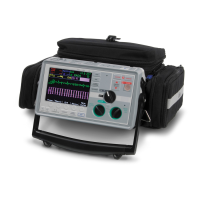Troubleshooting Guidelines
9650-1210-01 Rev. R 13-5
Defibrillator
Symptom Recommended Action
Excessive artifact when using paddles as ECG source.
• Ensure PADDLES is selected.
• Firmly press paddles against patient skin.
• Use gel on paddles.
• Clean paddle surface.
• Check and clean between adult and pediatric shoe.
• Check cable for damage.
• Use MFE electrodes for ECG analysis.
Defibrillator will not charge (energy level does not
increment on display).
• Check SHOCK button(s) on paddles or front panel are
not stuck on.
• Replace battery with a fully charged battery pack.
Charge time to 200 J exceeds 10 seconds.
• Typical in a low battery condition (up to 20 seconds)
• Change battery pack.
• Plug device into AC power.
• Install fully charged battery pack.
Energy does not discharge when you press SHOCK
button(s).
• 60 seconds have elapsed in Manual mode since initial
charge ready. Energy was internally discharged.
• 15 seconds have elapsed in automatic mode since
initial charge ready. Energy was internally discharged.
• Device is in SYNC mode and no QRS complex is
detected.
• Energy internally discharged because energy selection
was changed during charge or after the device was
ready.
• Unit not completely charged when you pressed SHOCK
button(s). Wait for DEFIB XXXJ READY message and
ready tone.
• Press and hold SHOCK button(s) until energy is
delivered to the patient.
• Device is connected to the AutoPulse Plus and no
relaxation period of the compression cycle has been
detected yet.
Unit is unable to SHOCK when in SYNC mode.
• Ensure SYNC XXXJ SEL message is displayed on
monitor.
• Check for SYNC marker above R wave. If not present,
change ECG size, lead selection, or electrode
placement.
• Press and hold SHOCK button(s) until energy is
delivered to the patient.
• Alter ECG electrode placement.
• Make sure ECG signals are displayed.

